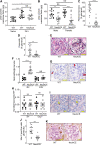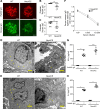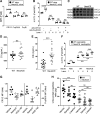Overexpressed angiotensin-converting enzyme in neutrophils suppresses glomerular damage in crescentic glomerulonephritis
- PMID: 35979968
- PMCID: PMC9484997
- DOI: 10.1152/ajprenal.00067.2022
Overexpressed angiotensin-converting enzyme in neutrophils suppresses glomerular damage in crescentic glomerulonephritis
Abstract
While angiotensin-converting enzyme (ACE) regulates blood pressure by producing angiotensin II as part of the renin-angiotensin system, we recently reported that elevated ACE in neutrophils promotes an effective immune response and increases resistance to infection. Here, we investigate if such neutrophils protect against renal injury in immune complex (IC)-mediated crescentic glomerulonephritis (GN) through complement. Nephrotoxic serum nephritis (NTN) was induced in wild-type and NeuACE mice that overexpress ACE in neutrophils. Glomerular injury of NTN in NeuACE mice was attenuated with much less proteinuria, milder histological injury, and reduced IC deposits, but presented with more glomerular neutrophils in the early stage of the disease. There were no significant defects in T and B cell functions in NeuACE mice. NeuACE neutrophils exhibited enhanced IC uptake with elevated surface expression of FcγRII/III and complement receptor CR1/2. IC uptake in neutrophils was enhanced by NeuACE serum containing elevated complement C3b. Given no significant complement activation by ACE, this suggests that neutrophil ACE indirectly preactivates C3 and that the C3b-CR1/2 axis and elevated FcγRII/III play a central role in IC elimination by neutrophils, resulting in reduced glomerular injury. The present study identified a novel renoprotective role of ACE in glomerulonephritis; elevated neutrophilic ACE promotes elimination of locally formed ICs in glomeruli via C3b-CR1/2 and FcγRII/III, ameliorating glomerular injury.NEW & NOTEWORTHY We studied immune complex (IC)-mediated crescentic glomerulonephritis in NeuACE mice that overexpress ACE only in neutrophils. Such mice show no significant defects in humoral immunity but strongly resist nephrotoxic serum nephritis (less proteinuria, milder histological damage, reduced IC deposits, and more glomerular neutrophils). NeuACE neutrophils enhanced IC uptake via increased surface expression of CR1/2 and FcgRII/III, as well as elevated serum complement C3b. These results suggest neutrophil ACE as a novel approach to reducing glomerulonephritis.
Keywords: C3; angiotensin-converting enzyme; complement; crescentic glomerulonephritis; immune complex; neutrophil.
Conflict of interest statement
No conflicts of interest, financial or otherwise, are declared by the authors.
Figures






Similar articles
-
Adverse functions of neutrophils are regulated by neutrophilic angiotensin-converting enzyme in immune complex-mediated crescentic glomerulonephritis.Am J Physiol Renal Physiol. 2025 Jul 1;329(1):F190-F201. doi: 10.1152/ajprenal.00378.2024. Epub 2025 Jun 17. Am J Physiol Renal Physiol. 2025. PMID: 40526025
-
A role for Mac-1 (CDIIb/CD18) in immune complex-stimulated neutrophil function in vivo: Mac-1 deficiency abrogates sustained Fcgamma receptor-dependent neutrophil adhesion and complement-dependent proteinuria in acute glomerulonephritis.J Exp Med. 1997 Dec 1;186(11):1853-63. doi: 10.1084/jem.186.11.1853. J Exp Med. 1997. PMID: 9382884 Free PMC article.
-
Endogenous myeloperoxidase promotes neutrophil-mediated renal injury, but attenuates T cell immunity inducing crescentic glomerulonephritis.J Am Soc Nephrol. 2007 Mar;18(3):760-70. doi: 10.1681/ASN.2006040375. Epub 2007 Jan 31. J Am Soc Nephrol. 2007. PMID: 17267745
-
Classical and nonclassical effects of angiotensin-converting enzyme: How increased ACE enhances myeloid immune function.J Biol Chem. 2024 Jun;300(6):107388. doi: 10.1016/j.jbc.2024.107388. Epub 2024 May 17. J Biol Chem. 2024. PMID: 38763333 Free PMC article. Review.
-
[Role of complement in experimental glomerulonephritis].Invest Clin. 1991;32(2):91-105. Invest Clin. 1991. PMID: 1807401 Review. Spanish.
Cited by
-
Role of local angiotensin II signaling in bladder function.Am J Physiol Renal Physiol. 2024 Nov 1;327(5):F726-F738. doi: 10.1152/ajprenal.00204.2024. Epub 2024 Sep 12. Am J Physiol Renal Physiol. 2024. PMID: 39265080 Review.
References
-
- Nishi H, Furuhashi K, Cullere X, Saggu G, Miller MJ, Chen Y, Rosetti F, Hamilton SL, Yang L, Pittman SP, Liao J, Herter JM, Berry JC, DeAngelo DJ, Zhu C, Tsokos GC, Mayadas TN. Neutrophil FcγRIIA promotes IgG-mediated glomerular neutrophil capture via Abl/Src kinases. J Clin Invest 127: 3810–3826, 2017. doi:10.1172/JCI94039. - DOI - PMC - PubMed
Publication types
MeSH terms
Substances
Associated data
Grants and funding
LinkOut - more resources
Full Text Sources
Research Materials
Miscellaneous

